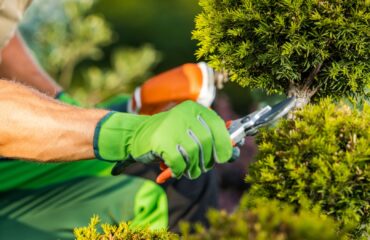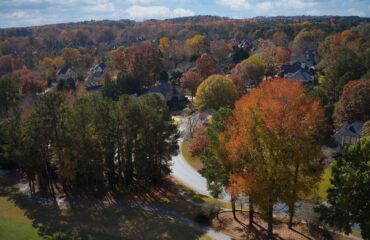
Strengthening Trees for Winter to Thrive in Spring
Fall tree trimming is essential for maintaining the health and vibrancy of trees in central Georgia. As the autumn air turns crisp, it’s the perfect time to prepare your trees for the colder months. Proper trimming now can enhance their health and ensure they withstand winter, blooming beautifully in spring.
This blog will guide you through the essentials of fall tree trimming, offering tips for different tree types to strengthen and fortify them. Learn how to select the right branches for trimming, the benefits of removing deadwood, and methods to encourage new growth. We’ll also provide safety tips and suggest the optimal timing for trimming to achieve the best results.
At Archer Tree Services, we’re dedicated to delivering top-quality tree-trimming services tailored to the unique needs of local trees. Our experienced team is ready to help keep your trees in prime condition with personalized advice and professional care. Let us assist you in preparing your trees for winter so they can flourish when spring arrives!
Why Fall is the Ideal Time for Tree Trimming
Fall is the perfect time for tree care in central Georgia! As the trees start their dormancy period, it’s the ideal moment to give them a trim. Why? Because during dormancy, trees handle cutting with much less stress, healing up quickly and efficiently. Plus, the cool weather means there’s less risk of pests and diseases messing with those fresh cuts.
Winter in Georgia can be unpredictable, with sudden chills and the occasional ice or snow. With fall tree trimming, you can say goodbye to dead or weak branches that might snap under winter’s weight, keeping your property safe and sound. This proactive approach not only helps avoid damage but also keeps the area safer for everyone nearby.
As you get ready for winter, remember that each tree species has its own special trimming needs. From the mighty oak to the elegant maple, every tree has unique traits that determine the best pruning approach. In the next section, we’ll dive into the common trees in central Georgia and their trimming needs, so you can give each tree in your yard the personalized care it deserves!
Common Georgia Trees & How Fall Tree Trimming Benefits Them
Taking care of trees requires a little extra attention, especially as the seasons change. Let’s dive into some common trees around central Georgia and see how fall tree trimming can help them thrive, along with some typical issues they might face:
- Southern Red Oak and Water Oak: These sturdy trees can collect deadwood, which invites pests and diseases. Giving them a fall clean-up by removing dead branches not only stops the spread of disease but also strengthens the tree, reducing the chance of branches breaking during winter storms.
- Sweetgum and Eastern Redbud: Fall is the perfect time to prune these trees for a more stable structure that supports spring growth. Sweetgums have a knack for producing lots of seed pods that can clutter your yard; strategic trimming keeps them in check. Eastern Redbuds can suffer from branch dieback, so fall pruning of weak branches ensures healthier growth come spring.
- Dogwood and Pecan: Light trimming helps these trees maintain their shape and remove any diseased branches. Dogwoods are prone to anthracnose, a pesky fungal disease that affects leaves and branches. Fall tree trimming can help prevent this. Pecans can develop cankers and deadwood, so pruning these away supports a healthier harvest next season.
- Magnolia and Live Oak: Though they need minimal pruning, a gentle trim helps maintain their natural beauty and prevents overgrowth. Magnolias can develop dense canopies that block light and reduce air circulation, increasing fungal infection risks. Light trimming improves airflow without stressing the tree. Live Oaks benefits from occasional pruning to remove low-hanging branches, promoting healthier growth and a more pleasing shape.
- Eastern White Pine and Crepe Myrtle: Fall tree trimming helps control their size and boosts healthy flowering next year. Eastern White Pines can get overcrowded, reducing vigor and making them pest targets. Thinning branches improve sunlight exposure and airflow. Crepe Myrtles often need pruning to keep their shape and encourage blooming; removing old seed pods and thinning branches in fall enhances flowering for the next year.
Overall, fall tree trimming is like a spa day for your trees, tackling issues like disease, pests, and structural weaknesses. This ensures they stay healthy and vibrant for years to come.
Which Branches to Cut for Healthier Trees
When it comes to trimming trees, selecting the right branches to remove is crucial for maintaining your trees’ health and vitality. Proper fall tree trimming not only enhances the tree’s appearance but also helps your tree thrive in the spring. Here’s what to look out for:
Dead or Diseased Branches
These compromised branches can spread illness, not just to your tree but to others nearby, potentially affecting an entire grove. Snipping them off helps stop the spread of disease, fosters new growth, and boosts air circulation within the tree canopy. Increased air flow can reduce moisture buildup, which often harbors pathogens.
Crossing Branches
When branches overlap or rub against each other, they can injure the bark, creating wounds susceptible to decay. This weakens the tree structurally and opens the door for pests and diseases, such as fungi that can compromise the tree’s health over time. Removing these problematic branches helps preserve the tree’s integrity and allows for better growth patterns.
Weak Branches
These branches are prone to snapping in strong winds or under the weight of heavy snow and ice, posing a hazard not only to the tree but also to property and safety. Branches with a V-shaped angle where they attach to the trunk are less stable compared to those with a sturdier U-shaped angle. Ensuring your tree’s branches have a healthy structural form reduces the likelihood of damage during severe weather events.
Remember, it’s important not to get carried away with your fall tree trimming! Cutting off too many branches can stress your tree, making it more susceptible to disease and insect infestations. Over-pruning can lead to a loss of nutrients and energy reserves, stunting growth and vitality.
When in doubt about which branches to cut, it might be time to call in the professionals. Our team has the expertise, knowledge, and specialized tools to make the right call, ensuring your tree stays in tip-top shape without risking accidental damage. Their guidance can yield a healthier, more resilient tree, enhancing your landscape’s beauty and functionality for years to come.
Tackling Fall Tree Trimming Safely
DIY projects can be super rewarding, giving you that awesome feeling of accomplishment and a chance to get creative. But when it comes to tree trimming, a little extra caution goes a long way. Without the right know-how, you could accidentally harm the tree or, even worse, injure yourself. Let’s dive into some safety tips to help make your fall tree trimming adventure successful and safe.
- Check Out the Tree and Its Surroundings: Before grabbing any tools, take a good look at the tree you want to trim. Keep an eye out for any signs of disease, decay, or structural issues. Also, check the area around the tree for potential hazards like power lines, buildings, or obstacles that might get in the way. Ensuring the tree is healthy and the environment is safe is a key part of your prep.
- Choose the Right Tools: The right tools can make all the difference in how easy and safe your project is. Make sure your gear is clean, sharp, and made for tree trimming. Using the wrong tools can make the job tougher and riskier, and might even damage the tree.
- Gear Up with Personal Protective Equipment (PPE): Safety is a big deal when trimming trees. Throw on a hard hat to shield your head from stray branches, gloves for a solid grip and hand protection, and eye protection against flying debris. PPE is your first defense against accidents and injuries.
- Know When to Call the Pros: Sometimes tree trimming gets tricky, especially with big trees or those near power lines. In these situations, it’s smart to call in the experts. Professional arborists have the experience, skills, and special equipment to handle these challenges safely. They know how to manage risks that you might miss.
At Archer Tree Services, we’re proud of our expert team who stands ready with the latest tools and safety practices to tackle even the toughest tree trimming jobs. Letting professionals handle the task not only keeps trees healthy but also ensures a safe environment for everyone involved–giving you peace of mind and great results.
Safe and Beautiful Landscapes Start with Expert Tree Care
Proper tree care, especially through strategic fall tree trimming, is essential for maintaining healthy and aesthetically pleasing landscapes. By removing diseased, dead, or problematic branches, trees can thrive and contribute positively to their environment.
While some pruning tasks can be managed by homeowners, engaging professionals like Archer Tree Services ensures that the job is done safely and effectively, protecting both the trees and those around them. Placing your trust in experts not only ensures your trees continue to thrive but also enhance the beauty and safety of your surroundings.
Don’t risk your safety—or your trees’ well-being—by attempting to handle tree care on your own. Let the professionals at Archer Tree Services manage your fall tree trimming with precision. We use cutting-edge techniques and equipment to ensure reliable results. Interested in learning more or scheduling a consultation? Contact us today!



